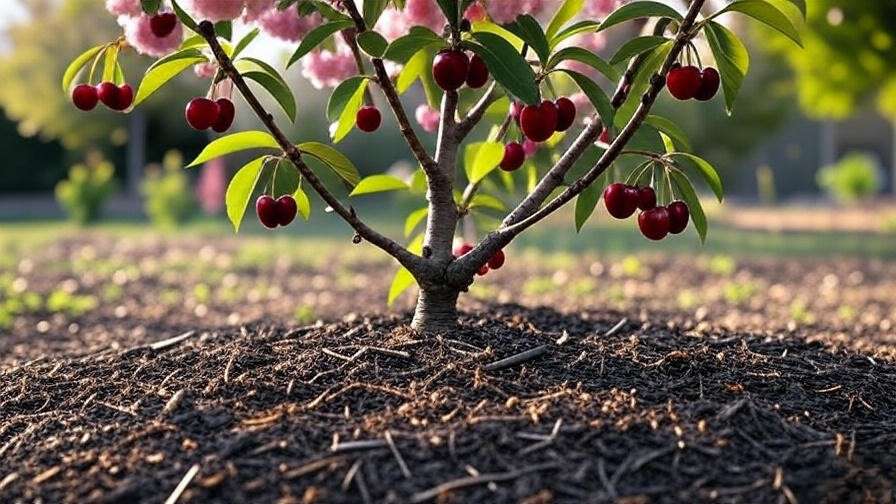Picture this: a compact bush cherry tree in your backyard, its branches heavy with sweet, juicy cherries you grew yourself! 🍒 The satisfaction of harvesting homegrown fruit is unmatched, and bush cherry trees make it easy, even for beginners. These pint-sized powerhouses are perfect for small gardens, urban spaces, or even large pots, offering vibrant spring blossoms, delicious fruit, and stunning fall foliage. Whether you’re a seasoned gardener or just starting, this guide will walk you through every step to grow a thriving bush cherry tree. From planting to harvesting, we’ve got you covered with expert tips to ensure a bountiful harvest. Let’s dig in! 🌿
What Is a Bush Cherry Tree? 🌳
Defining the Bush Cherry Tree
Unlike traditional cherry trees that tower over gardens, bush cherry trees are compact, shrub-like plants, typically growing 4-8 feet tall. These hardy beauties, such as the Nanking or Carmine Jewel varieties, are bred for small spaces and cold climates (USDA Hardiness Zones 2-7). Their low-maintenance nature and prolific fruit production make them a favorite among home gardeners. Plus, their springtime pink or white blossoms and vibrant fall leaves add ornamental charm to any landscape. 🌸
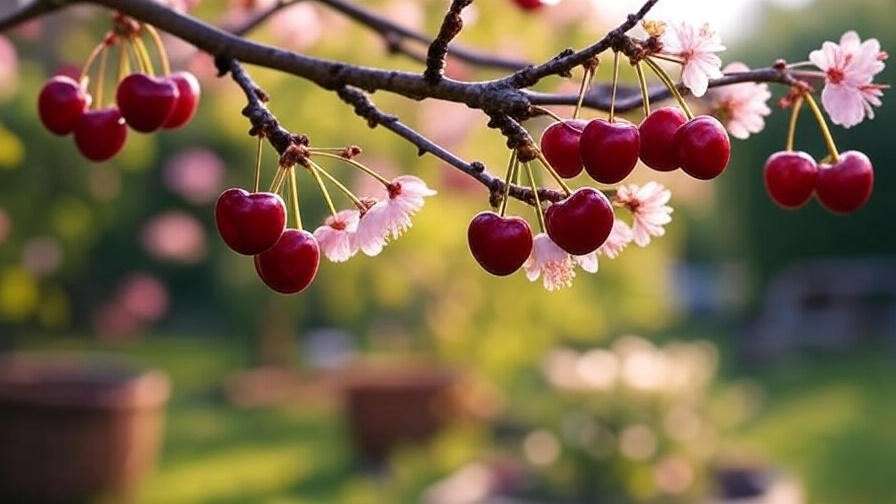
Popular Varieties of Bush Cherry Trees
Choosing the right variety is key to success. Here are some top picks:
- Nanking Cherry: Known for its tart, bright red fruit, perfect for jams and pies. Thrives in Zones 2-6.
- Carmine Jewel: A dwarf variety with sweet-tart cherries, ideal for fresh eating. Zones 3-7.
- Romeo and Juliet: Often planted together for cross-pollination, these produce sweet, dark cherries. Zones 2-7.
Expert Tip: Check your USDA zone and select a variety suited to your climate for the best results. 🌞 Resources from the University of Minnesota Extension can guide variety selection.
Benefits of Growing a Bush Cherry Tree 🍒
Why Choose a Bush Cherry Tree?
Bush cherry trees are a gardener’s dream for several reasons:
- Space Efficiency: Their compact size fits small yards, patios, or even containers.
- High Yield: A single bush can produce gallons of cherries with proper care.
- Ornamental Appeal: Spring blossoms and colorful fall foliage make them a year-round showstopper. 🍂
These traits make them ideal for urban gardeners or anyone with limited space.
Nutritional and Culinary Value
Cherries are packed with antioxidants, vitamins C and A, and fiber, offering health benefits like improved heart health and reduced inflammation (USDA FoodData Central). Bush cherries shine in the kitchen, whether eaten fresh, baked into pies, or turned into jams. Try this quick idea: simmer fresh bush cherries with sugar and lemon juice for a tangy jam to spread on toast. 🍞
Planting Your Bush Cherry Tree 🌱
Choosing the Right Location
To thrive, bush cherry trees need:
- Sunlight: 6-8 hours of full sun daily for optimal fruit production. ☀️
- Soil: Well-draining, loamy soil with a pH of 6.0-7.0. Test your soil with a home kit for accuracy.
- Spacing: Plant trees 4-6 feet apart to ensure good airflow and growth.
Avoid low-lying areas where frost can settle, as this may damage early spring buds. ❄️
When and How to Plant
The best time to plant is early spring or fall when the tree is dormant. Follow these steps:
- Dig a hole twice as wide and as deep as the root ball.
- Mix compost into the soil to boost nutrients.
- Place the tree in the hole, ensuring the root collar is level with the ground.
- Backfill with soil, tamping gently to remove air pockets.
- Water deeply and add a 2-3 inch layer of mulch to retain moisture.
Expert Tip: Water thoroughly after planting to help roots settle. The Royal Horticultural Society recommends consistent moisture for new trees.
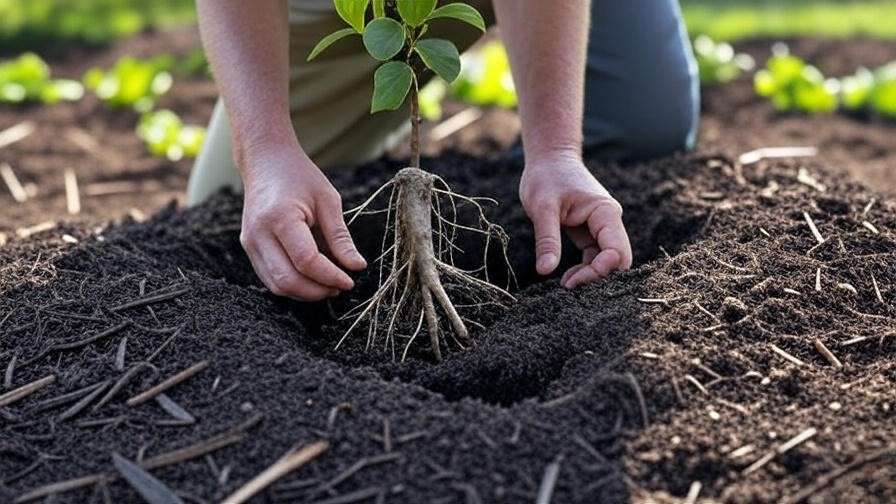
Container Gardening for Bush Cherries
For urban gardeners or renters, bush cherries thrive in containers:
- Pot Size: Use a 15-20 gallon pot with drainage holes.
- Soil Mix: Combine potting soil with compost and perlite for drainage.
- Care: Place in a sunny spot and water regularly, as pots dry out faster.
This method is perfect for patios or balconies, bringing fruit to small spaces.
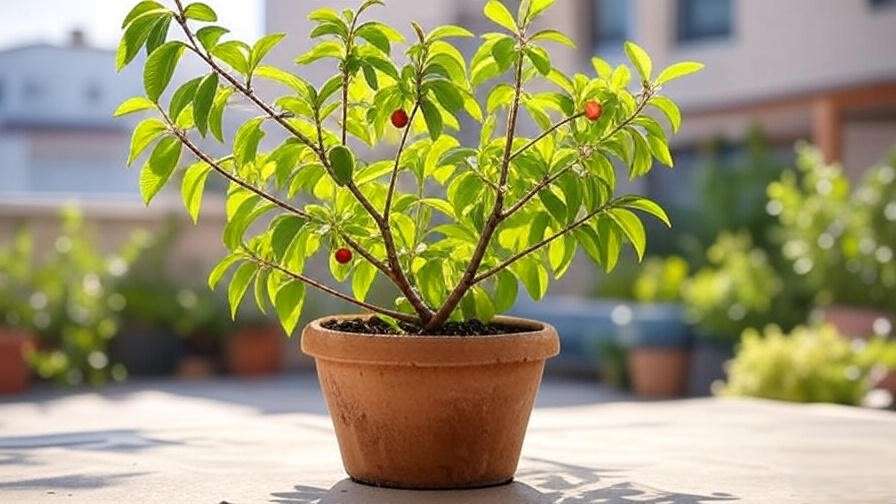
Caring for Your Bush Cherry Tree 🌿
Watering Needs
Consistent moisture is crucial, especially in the first year:
- Frequency: Water deeply 1-2 times per week, adjusting for rainfall.
- Signs of Trouble: Yellowing leaves may indicate overwatering; wilting suggests underwatering.
- Tip: Use a soaker hose for even, deep watering. 💧 Check soil moisture 2 inches down before watering again.
Fertilizing for Optimal Growth
Feed your tree to promote healthy growth and fruiting:
- Type: Use a balanced 10-10-10 fertilizer or organic compost.
- Timing: Apply in early spring and again in mid-summer.
- Caution: Over-fertilizing can lead to lush foliage but fewer cherries, so follow package instructions.
The University of Minnesota Extension suggests soil testing to tailor fertilization.
Pruning for Health and Productivity
Pruning keeps your tree healthy and productive:
- When: Late winter or early spring, before buds swell.
- How:
- Remove dead, damaged, or diseased branches.
- Thin crowded areas to improve airflow and light penetration.
- Shape the bush to maintain an open structure.
- Visual Aid: A pruning diagram can help visualize cuts (consider adding one to your article).
Proper pruning reduces disease risk and boosts fruit yield.
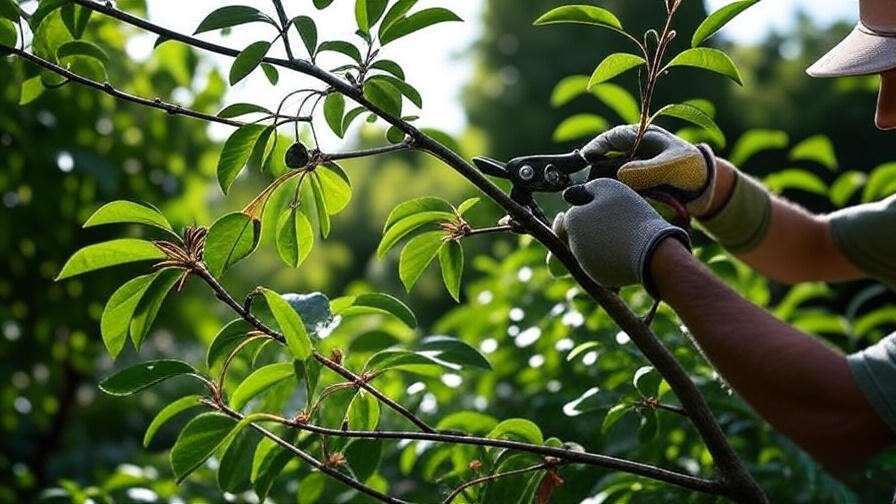
Mulching and Weed Control
Mulch is a game-changer for bush cherry trees:
- Benefits: Retains moisture, suppresses weeds, and regulates soil temperature.
- Materials: Use wood chips, straw, or shredded bark, applying a 2-3 inch layer around the base (keep it away from the trunk).
- Weed Control: Pull weeds manually or use mulch to prevent competition for nutrients.
This simple step saves time and keeps your tree thriving.
Protecting Your Bush Cherry Tree from Pests and Diseases 🐞
Common Pests
Bush cherry trees can attract:
- Aphids: Small sap-sucking insects that curl leaves. Control with neem oil or insecticidal soap.
- Japanese Beetles: Shiny beetles that chew leaves. Hand-pick or use traps.
- Cherry Fruit Flies: Lay eggs in fruit, causing maggots. Use organic sprays or sticky traps.
Encourage natural predators like ladybugs for eco-friendly pest control. 🐞
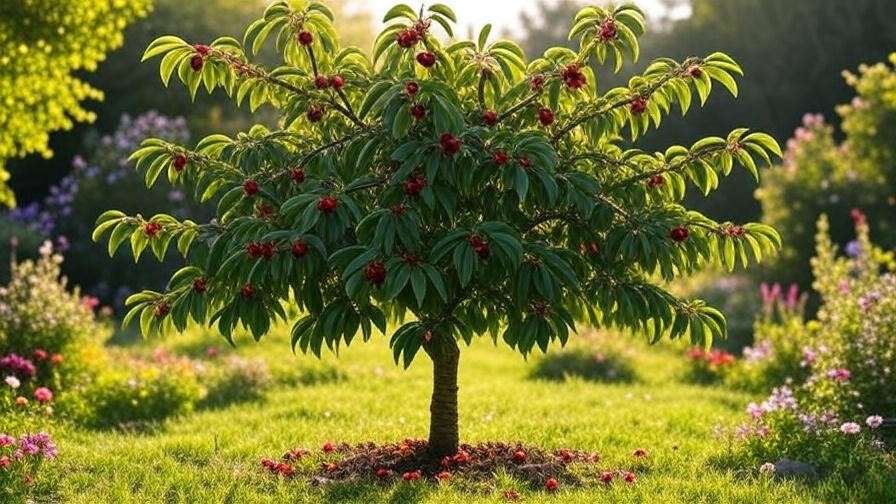
Common Diseases
Watch for these issues:
- Brown Rot: Fungal disease causing fruit rot. Prevent with good airflow and timely fungicide (if needed).
- Powdery Mildew: White coating on leaves. Improve air circulation and apply organic fungicides.
- Leaf Spot: Dark spots on leaves. Remove affected leaves and avoid overhead watering.
Expert Tip: Rake and dispose of fallen leaves to reduce disease risk. 🍃 Cornell Extension provides detailed disease management strategies.
Winter Protection
Though cold-hardy, bush cherries benefit from winter care in harsh climates:
- Mulch: Add a thick layer around the base to insulate roots.
- Wrap Trunks: Use tree wraps to protect against rodents and frost cracks.
- Frost Blankets: Cover young trees during extreme cold snaps.
These steps ensure your tree emerges healthy in spring.
Harvesting and Enjoying Your Bush Cherries 🍒
When to Harvest
Timing is everything for perfect cherries:
- Signs of Ripeness: Deep color (red to dark purple, depending on variety), slight give when squeezed, and sweet-tart flavor.
- Timing: Typically mid-summer (June-July), varying by variety and climate.
Test a few cherries to confirm ripeness before harvesting.
How to Harvest
Harvest gently to protect fruit and branches:
- Method: Hand-pick cherries, twisting gently to avoid tearing.
- Tip: Harvest in the morning when fruit is cool for the best flavor and shelf life.
Use a basket to collect cherries without bruising.
Storing and Preserving Cherries
Enjoy your cherries fresh or preserve them:
- Short-Term: Refrigerate in a perforated bag for up to 3 weeks.
- Long-Term:
- Freezing: Wash, pit, and freeze cherries on a tray before transferring to bags.
- Canning: Make jams or preserves for year-round enjoyment.
- Drying: Use a dehydrator for chewy, sweet snacks.
Try this: Freeze cherries in single portions for smoothies or baking. 🍒
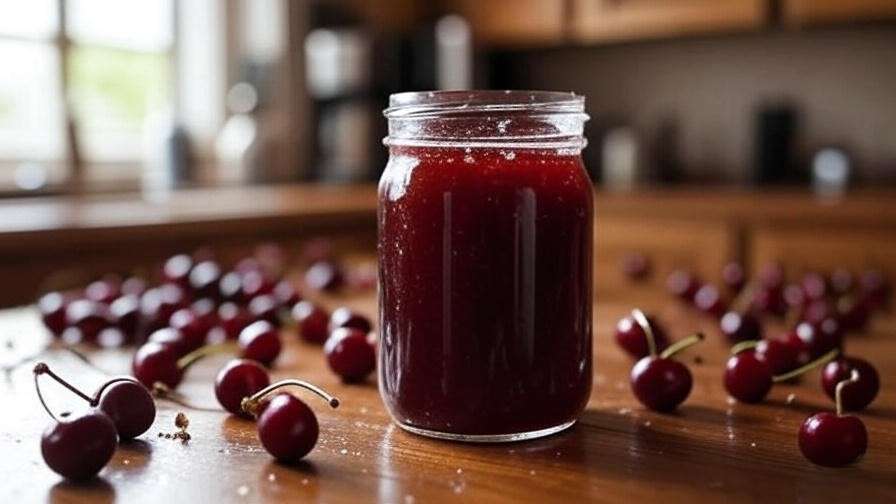
Troubleshooting Common Bush Cherry Tree Problems ⚠️
Why Isn’t My Tree Fruiting?
If your tree isn’t producing, consider:
- Pollination: Some varieties need a second tree for cross-pollination. Check if yours is self-pollinating (e.g., Carmine Jewel) or needs a partner (e.g., Nanking).
- Pruning Issues: Over-pruning can remove fruiting wood. Follow pruning guidelines.
- Nutrient Deficiency: Test soil and adjust fertilization.
Planting a pollinator-friendly variety nearby can boost fruit set.
Yellowing Leaves or Stunted Growth
Diagnose and fix:
- Overwatering: Check for soggy soil; improve drainage.
- Poor Nutrition: Apply a balanced fertilizer or compost.
- Pests/Diseases: Inspect for aphids, mildew, or leaf spot and treat promptly.
A soil test from your local extension service can pinpoint issues.
Expert Tips for Maximizing Your Bush Cherry Tree’s Potential 🌟
Companion Planting
Boost your tree’s health with companions:
- Good Partners: Marigolds, chives, or garlic deter pests naturally.
- Avoid: Nightshades (e.g., tomatoes, potatoes) that share diseases with cherries.
This strategy creates a thriving garden ecosystem.
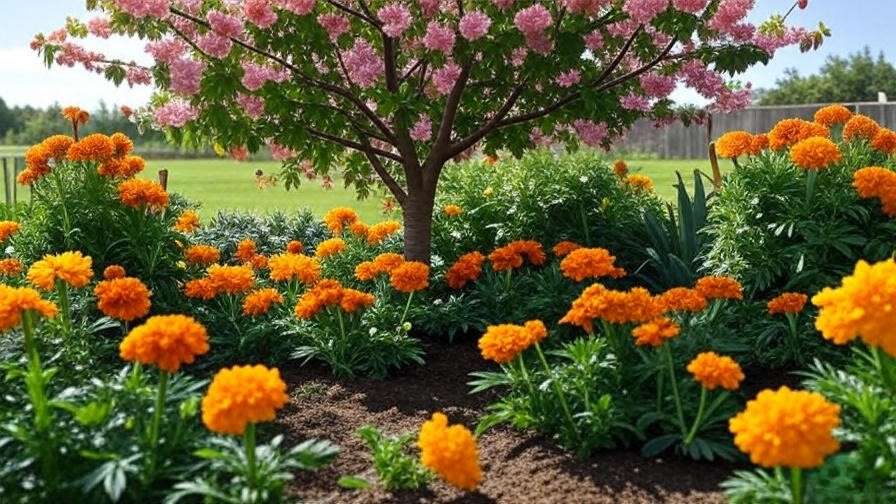
Pollinator Attraction
Encourage pollination for better yields:
- Flowers: Plant lavender, bee balm, or clover nearby to attract bees and butterflies. 🐝
- Cross-Pollination: For non-self-pollinating varieties, ensure a compatible tree is within 50 feet.
Pollinators are key to a bumper crop.
Sustainable Practices
Go green with these tips:
- Organic Fertilizers: Use compost or fish emulsion for eco-friendly nutrition.
- Compost: Recycle kitchen scraps to enrich soil naturally.
- Water Conservation: Use drip irrigation to minimize waste.
Sustainable care benefits both your tree and the planet. 🌍
FAQs About Bush Cherry Trees ❓
Q: Do bush cherry trees need a pollinator?
A: Some varieties, like Carmine Jewel, are self-pollinating, while others, like Nanking, benefit from a second tree. Check your variety’s requirements.
Q: How long does it take for a bush cherry tree to bear fruit?
A: Expect fruit in 2-4 years, depending on the variety, care, and growing conditions.
Q: Can bush cherry trees grow in pots?
A: Yes! Use a 15-20 gallon pot with good drainage and a sunny location.
Q: How do I protect my tree from birds?
A: Use bird netting or reflective tape to deter birds without harming them.
These answers draw from trusted sources like the University of Minnesota Extension.
Conclusion 🌼
You’re now equipped with everything you need to grow a thriving bush cherry tree! 🍒 From selecting the perfect variety to mastering planting, care, and harvesting, this guide has covered the essentials to ensure your tree flourishes. Bush cherry trees are a delightful addition to any garden, offering delicious fruit, stunning blossoms, and the joy of homegrown harvests. Start small, follow these expert tips, and soon you’ll be savoring cherries from your own backyard. Ready to get started? Plant your bush cherry tree today and share your progress in the comments below! 🌱 For more gardening inspiration, check out our articles on growing fruit trees in small spaces or organic pest control techniques.

